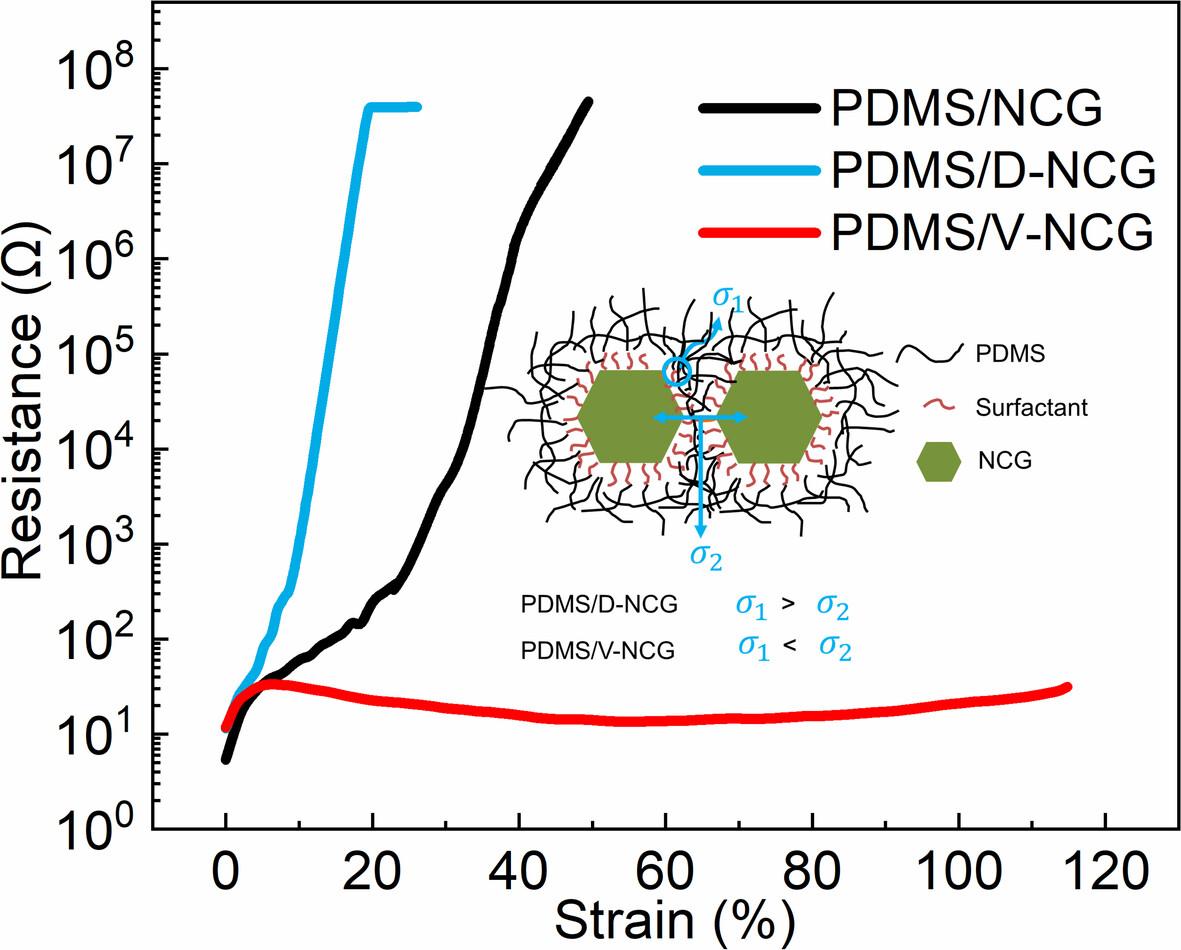A highly stretchable and conductive polydimethylsiloxane/nickel-coated graphite composite prepared by a facile sedimentation method by adjusting interface effects
Rong Zhang, Qian Liu, Yifan Xiang, Siqi Li, Wuhou Fan, Chengcheng Xu, Qingting Liu, Xudong Fu, Shengfei Hu
求助PDF
{"title":"A highly stretchable and conductive polydimethylsiloxane/nickel-coated graphite composite prepared by a facile sedimentation method by adjusting interface effects","authors":"Rong Zhang, Qian Liu, Yifan Xiang, Siqi Li, Wuhou Fan, Chengcheng Xu, Qingting Liu, Xudong Fu, Shengfei Hu","doi":"10.1002/pi.6675","DOIUrl":null,"url":null,"abstract":"<p>Stretchable electrodes are essential parts for flexible electronics which are widely applied in human health monitoring, wearable electronics, robotics etc. Conductive elastomer composites are good candidates for stretchable electrodes; however, it is a challenge to maintain the resistance of conductive elastomer composites during elongation due to the departure of filler networks. In this work, highly stretchable and conductive polydimethylsiloxane (PDMS)/nickel-coated graphite (NCG) composites were fabricated based on the filler sedimentation method, in which NCG was modified by the coupling agent of the end alkyl group (dodecyltriethoxysilane, DTES) and end vinyl group (vinyltriethoxysilane, VTEO), considering the force between the filler networks and filler–matrix interface. The DTES modified NCG mainly improved the filler–matrix interface, which made the resistance of the composites clearly increase with strain, while the VTEO mainly heightened the NCG networks and made the resistance of the composites insensitive to a strain of 114% when the NCG content was 23.1 wt%. These quite interesting results are closely related to the force between the filler networks and filler–matrix interface during strain and they were proved in detail through the mechanical and electrical hysteresis performance. This work presents a facile method from the concept of stability of filler networks during strain to prepare highly stretchable and conductive composites. © 2024 Society of Chemical Industry.</p>","PeriodicalId":20404,"journal":{"name":"Polymer International","volume":"73 11","pages":"959-969"},"PeriodicalIF":2.9000,"publicationDate":"2024-07-11","publicationTypes":"Journal Article","fieldsOfStudy":null,"isOpenAccess":false,"openAccessPdf":"","citationCount":"0","resultStr":null,"platform":"Semanticscholar","paperid":null,"PeriodicalName":"Polymer International","FirstCategoryId":"92","ListUrlMain":"https://onlinelibrary.wiley.com/doi/10.1002/pi.6675","RegionNum":4,"RegionCategory":"化学","ArticlePicture":[],"TitleCN":null,"AbstractTextCN":null,"PMCID":null,"EPubDate":"","PubModel":"","JCR":"Q2","JCRName":"POLYMER SCIENCE","Score":null,"Total":0}
引用次数: 0
引用
批量引用
Abstract
Stretchable electrodes are essential parts for flexible electronics which are widely applied in human health monitoring, wearable electronics, robotics etc. Conductive elastomer composites are good candidates for stretchable electrodes; however, it is a challenge to maintain the resistance of conductive elastomer composites during elongation due to the departure of filler networks. In this work, highly stretchable and conductive polydimethylsiloxane (PDMS)/nickel-coated graphite (NCG) composites were fabricated based on the filler sedimentation method, in which NCG was modified by the coupling agent of the end alkyl group (dodecyltriethoxysilane, DTES) and end vinyl group (vinyltriethoxysilane, VTEO), considering the force between the filler networks and filler–matrix interface. The DTES modified NCG mainly improved the filler–matrix interface, which made the resistance of the composites clearly increase with strain, while the VTEO mainly heightened the NCG networks and made the resistance of the composites insensitive to a strain of 114% when the NCG content was 23.1 wt%. These quite interesting results are closely related to the force between the filler networks and filler–matrix interface during strain and they were proved in detail through the mechanical and electrical hysteresis performance. This work presents a facile method from the concept of stability of filler networks during strain to prepare highly stretchable and conductive composites. © 2024 Society of Chemical Industry.
通过调整界面效应,采用简便沉积法制备高拉伸性和导电性聚二甲基硅氧烷/镍涂层石墨复合材料
可拉伸电极是柔性电子产品的重要部件,广泛应用于人体健康监测、可穿戴电子产品、机器人等领域。导电弹性体复合材料是拉伸电极的良好候选材料;然而,由于填料网络的脱离,在拉伸过程中保持导电弹性体复合材料的电阻是一项挑战。考虑到填料网络和填料-基质界面之间的作用力,本研究采用填料沉降法,通过端烷基(十二烷基三乙氧基硅烷,DTES)和端乙烯基(乙烯基三乙氧基硅烷,VTEO)偶联剂对 NCG 进行改性,制备了高拉伸导电性聚二甲基硅氧烷(PDMS)/镍涂层石墨(NCG)复合材料。当 NCG 含量为 23.1 wt% 时,DTES 改性的 NCG 主要改善了填料-基体界面,使复合材料的电阻随应变明显增加;而 VTEO 主要增强了 NCG 网络,使复合材料的电阻对 114% 的应变不敏感。这些有趣的结果与应变过程中填料网络和填料-基体界面之间的作用力密切相关,并通过机械和电滞后性能得到了详细证明。这项工作从填料网络在应变过程中的稳定性概念出发,提出了一种制备高拉伸性和导电性复合材料的简便方法。© 2024 化学工业协会。
本文章由计算机程序翻译,如有差异,请以英文原文为准。



